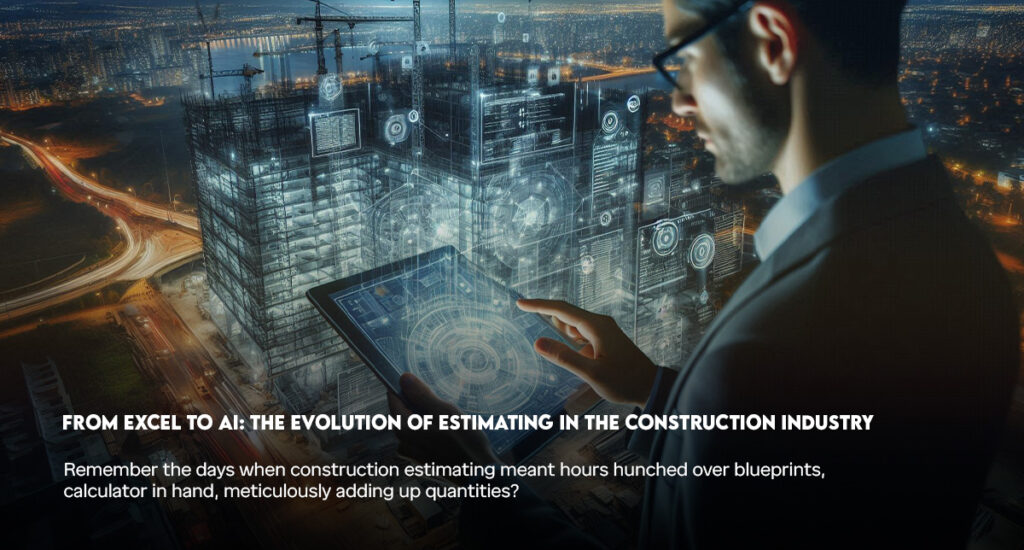Remember the days when construction estimating meant hours hunched over blueprints, calculator in hand, meticulously adding up quantities? For many years, Microsoft Excel was the king of this process, and for good reason! It brought order to chaos, allowing us to manage numbers and calculations far better than paper and pencil.
But the construction world is always moving forward, and so is technology. We’ve come a long way from those early Excel days. Today, Artificial Intelligence (AI) is transforming how we estimate projects, making the process faster, more accurate, and much smarter. It’s not about replacing human experts, but about giving them superpowers!

The Old Way: The Reign of Excel
Excel was a game-changer when it first arrived. It allowed estimators to:
- Organize Data: Instead of messy ledger books, numbers could be neatly arranged in rows and columns.
- Automate Calculations: Formulas meant fewer manual errors and quicker sums.
- Create Templates: Once a project type was estimated, the template could be reused, saving time.
- Flexibility: Excel is incredibly flexible, allowing users to customize it for various needs.
Even today, many in the industry still rely heavily on Excel for its simplicity and familiarity. However, as projects grew more complex and the need for speed and precision increased, Excel started to show its limits.
The Limits of Manual and Semi-Automated Estimating
While Excel was a great step, it still came with challenges:
- Time-Consuming Takeoffs: Measuring areas and counting items from drawings was a manual, often tedious, process.
- Human Error: Even the best estimators can make mistakes, leading to costly errors in bids.
- Outdated Data: Material prices and labor rates change quickly. Keeping Excel spreadsheets updated in real-time was a constant struggle.
- Collaboration Headaches: Sharing and updating Excel files among a team could lead to “version control” nightmares – who has the latest numbers?
- Limited Insights: Excel is good for crunching numbers, but it doesn’t easily show you hidden risks or opportunities in your data.
- Dependence on Experience: New estimators often rely heavily on the experience of senior colleagues, making the learning curve steep.
These limitations often meant lost time, lost bids, and sometimes, even lost profits.
Also Read: Beyond the Bricks and Mortar: Why Waterproofing and Insulation are Your Building’s Best Friends
The Digital Shift: Early Software Solutions
As computers became more powerful, specialized estimating software started to appear. These tools were designed specifically for construction and offered features like:
- Digital Takeoffs: Estimators could now measure directly on digital drawings, reducing the need for paper plans and manual measurements.
- Database Integration: Software could store and retrieve historical cost data, making estimates more consistent.
- Report Generation: Easier creation of professional-looking reports and proposals.
These tools were a big step forward, but many still lacked the real-time collaboration and advanced insights that today’s cloud-based and AI-powered solutions offer.
The AI Revolution: Estimating Gets Smarter
Now, we’re in the era of AI. AI in construction estimating isn’t about replacing the estimator; it’s about making them vastly more efficient and accurate. AI tools can analyze huge amounts of data, learn from past projects, and even “see” and understand elements on drawings in ways that were once impossible.
Here’s how AI is changing the game:
- Automated Takeoffs: This is perhaps the most immediate and impactful change. AI can “read” your blueprints (PDFs, CAD files) and automatically identify, measure, and count building elements like walls, doors, windows, and even specific fixtures. What used to take hours or days can now be done in minutes with incredible accuracy.
- Benefit: Saves massive amounts of time, reduces errors, and allows estimators to focus on strategy rather than repetitive tasks.
- Predictive Costing: AI can analyze vast historical project data, market trends, and even weather patterns to predict material and labor costs with amazing accuracy. It can flag potential price changes or supply chain issues before they become a problem.
- Benefit: More precise bids, better budget control, and reduced risk of unexpected cost overruns.
- Risk Assessment: AI can compare a new project’s details with thousands of past projects, identifying potential risks that might otherwise be missed. For example, it might flag if a subcontractor’s bid is unusually low compared to similar past projects, indicating a potential quality or delay risk.
- Benefit: Helps avoid costly mistakes and allows for better risk management in bids.
- Scenario Planning: Want to see how a different material choice or construction method would affect the overall cost and timeline? AI can quickly run various scenarios, giving you a clear picture of the financial impact of different decisions.
- Benefit: Enables more informed decision-making and allows for optimized bidding strategies.
- Blueprint Interpretation (Computer Vision): Advanced AI can actually “see” patterns in architectural drawings. This means it can not only measure but also understand the relationships between different building components, suggesting optimal material usage and minimizing waste.
- Benefit: Leads to more efficient material use and cost savings.
- Real-time Data Integration: AI-powered platforms can link directly with databases of current material prices, labor rates, and even subcontractor availability. This ensures your estimates are always based on the most up-to-date information.
- Benefit: Bids are always competitive and realistic, reflecting current market conditions.
My Go-To Tech Stack for Modern Estimating
For me, the best approach involves a combination of specialized software that leverages AI and cloud technology, while still keeping a practical, human touch. Here’s the tech stack I trust:
- Primary Estimating Software (AI-Powered): For automated takeoffs and initial quantity extraction, I rely on tools like Kreo Software or Togal.AI. These platforms are fantastic for quickly getting accurate quantities from PDFs and CAD files. They dramatically cut down the time spent on manual measurements, allowing me to focus on the strategic pricing and analysis.
- Why I trust them: Their AI is constantly learning and improving, delivering impressive accuracy. The speed they offer is unmatched, letting me bid on more projects.
- Cloud-Based Collaboration Platform: For project management and team collaboration, I use Procore. While not purely an estimating tool, its ability to centralize project documents, track progress, and facilitate communication is invaluable. It helps ensure that everyone on the team has access to the latest drawings, specifications, and estimate revisions.
- Why I trust it: It brings everyone onto the same page, reducing miscommunication and ensuring everyone is working with the most current information.
- Data Analysis & Reporting (with a touch of familiar flexibility): Even with AI doing much of the heavy lifting, there’s still a place for deeper analysis and customized reporting. Here, I use Microsoft Excel, but in a more advanced way. I import the detailed quantities from the AI takeoff software into Excel, where I can then apply custom formulas, run detailed cost breakdowns, and create highly tailored reports for clients. It also acts as a flexible bridge if I need to integrate data with other legacy systems.
- Why I trust it: Its flexibility allows for custom analysis and presentation, and it’s universally understood, making it easy to share complex data.
- Communication & General Productivity: For daily communication, scheduling, and quick data lookups, tools like Microsoft Teams or Google Workspace (Sheets/Docs) are indispensable. They keep the team connected and ensure quick access to information on the go.
- Why I trust them: Essential for keeping projects moving smoothly and for immediate communication.
The Future is Collaborative and Intelligent
The journey from manual calculation to AI-driven insights has been remarkable. The future of construction estimating is not just about using powerful software; it’s about a smarter, more connected, and more collaborative way of working. AI is helping us move away from just “guessing” costs to making truly informed, data-driven decisions.
It means more competitive bids, fewer surprises during projects, and ultimately, more successful outcomes for everyone involved. For construction professionals, embracing these technologies isn’t just about staying competitive; it’s about building a better, more efficient, and more profitable future for our industry.
What tools are you finding essential in your estimating workflow? Share your thoughts in the comments!
